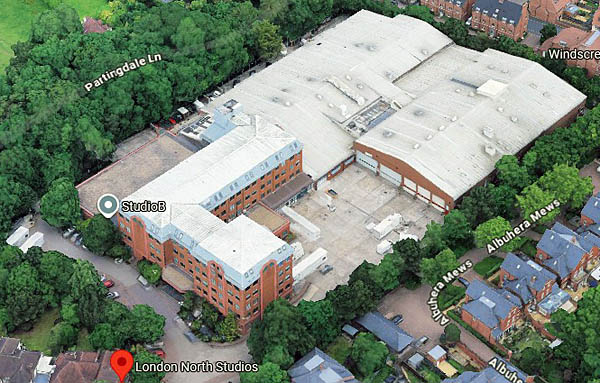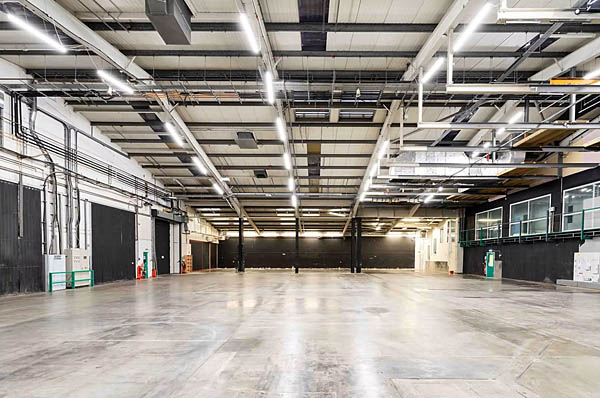Please note that this website is run on a non-profit basis for educational and research purposes. Images are credited with their respective copyright holders where they are known. You may not copy any image for commercial purposes. Please do not ask me for permission to use any images – that permission is not mine to give. If you are the copyright holder for an image and wish it to be removed, please contact me via the form at the foot of the page and I will of course be happy to do so. Also, if you are the owner of an uncredited image and wish to be named, again please contact me and I’ll happily add that information.
since July 2021

image thanks to Google Maps
In July 2021 another new film studio in London was announced, called London North Studios. It’s in Mill Hill, 5 minutes from the M1 and 8 minutes from the North Circular, according to their website. The facility is run by the studio management team and the property owner, Ridgeway Properties. The first production to film here in the summer of 2021 was a drama for Sky.
This is another conversion of some industrial premises. The German firm of Carl Zeiss built an optical works on the site in 1912, which was closed during the First World War but reopened around 1919 as the United Kingdom Optical Co Ltd. It was then purchased by the Jehovah’s Witnesses in 1986, who demolished the old buildings and constructed warehouses and offices, opening them in 1993. It was where their magazine The Watchtower was printed and distributed so it contains an attractive office block and several large structures suitable for use as film stages. (See more info on this at the bottom of this page.)
Technically of course, these are better described as ‘build spaces’ as they don’t have the normal things found in a purpose-built film stage such as high quality sound-proofing and deadening and a grid with easy access, suitable for suspending lights and scenery. However, many features and TV dramas have been filmed in premises like this so it is by no means a serious limitation. I should point out that these premises are very large and contain many useful rooms and areas that can be used as filming locations.

image thanks to London North Studios
The spaces on offer are as follows:
studio 1 – 13,000 sq ft
studio 2 – 10,000 sq ft
studio 3 – 7,500 sq ft
studio 4 – 8,600 sq ft
studio 5 – 2,850 – this appears to be more of a workshop than a filming stage
studio 6 – 4,650 sq ft (only 12ft height)
studio 7 – 3,200 sq ft (only 12ft height) suitable as a prop/wardrobe store
studio 8 – 1,115 sq ft (10 ft ceiling)
As well as plenty of office space, the studios also have a 300-person dining hall, commercial kitchen and 18 hair and costume rooms, as well as five acres of outdoor space, including an acre of woodland. There are also several other areas including workshops, prop stores, green rooms, meeting rooms and rehearsal rooms.
Credits include Stath Lets Flats (C4), A Christmas No 1 (Sky), The Diplomat (Netflix), Blood (Sky), A Spy Among Friends (ITV), The Stand Up Sketch Show, Code 404, The Capture, Trigger Point, Something in the Water, Riches (Prime Video), Bloods, Deep Lover, We Live in Time, Everything Now, The Critic, Still Up (Apple TV+), Insomnia.
They have a very impressive fly-through video on their website that can be viewed here.
Steve Canning is a local historian and has been kind enough to contact me. Regarding the previous use of the building, he points out that Jehovah’s Witnesses were a large part of the history of Mill Hill between the mid 1950s and 2020. He has informed me that they used to publish an annual Yearbook. The year 2000 edition includes the extract below, which details the purchase and development of the Bittacy Hill site. I hope they won’t mind me reproducing it here:
N. H. Knorr, who was then president of the Society, had observed that a building belonging to the U.K. Optical company and located across the road from Watch Tower House would make ideal premises for a printery. At that time, however, it was not available. But in September 1986 at a meeting organized by the Post Office, Philip Harris, the overseer of our Shipping Department, heard that the U.K. Optical company would be vacating those premises at Bittacy Hill. Immediately, arrangements were made to acquire this five-acre property. Two months later the sale was completed, and at the same time, negotiations to sell the Wembley factory were successfully concluded. Then, construction on the new factory began in earnest.
First, old buildings at the rear of the Bittacy Hill site were demolished to make way for the new factory. As excavation progressed, the brothers discovered that this area had been used as a dump for industrial waste. By the time all the rubble had been removed, it was evident that a large basement could be added to the building plans. More than 5,000 volunteers, from both Britain and overseas, spent over half a million hours on the project. The result was a fine factory and garage that could serve for years to come.
The second phase of the construction involved the demolition of the old U.K. Optical office and factory block to make room for the new office building. To maintain an appearance similar to that of other buildings in the neighborhood, the local planning authority insisted that our new office block be built with bricks. This was achieved by using half bricks set into concrete panels. The IBSA House quickly took shape as its 157 brick-faced panels were lifted into place. The manager of one company who visited the site soon afterward asked how many bricklayers we had employed. “Surely at least fifty,” he mused. He shook his head in disbelief upon learning that only six women and two men had done it all!
In 1993 this new office and factory complex at the top of Bittacy Hill was ready for use. It was dedicated during a visit by Albert D. Schroeder of the Governing Body.
